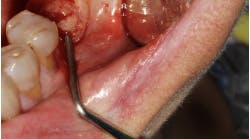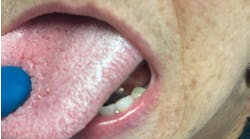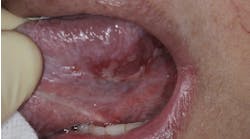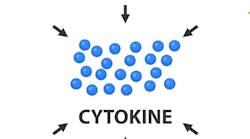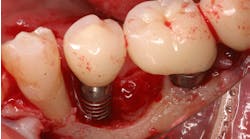NYU professors receive $369,250 to study oral cancer pain
Up to 90% of cancer patients suffer from pain, with oral cancer ranked consistently as one of the most painful cancers. The quality of life for oral cancer patients is the lowest of any patients suffering from cancer because the intense uncontrolled pain interferes with necessary oral functions including eating, talking and swallowing.
“Oral cancer pain is more severe, and the opioid requirement is higher, than pain from any other cancer,” said Brian L. Schmidt, DDS, MD, PhD, professor in NYU's Department of Oral and Maxillofacial Surgery, and director of NYU’s Bluestone Center for Clinical Research and the NYU Oral Cancer Center. “And in the end, pharmacological agents used to treat cancer pain often lack anatomical specificity and produce off-target effects that create additional suffering.”
“Gene therapy is emerging as an exciting prospect and alternative to opioids for the treatment of cancer pain,” said Seiichi Yamano, DDS, PhD, DMD, MMSc, assistant professor of prosthodontics at NYU College of Dentistry. “We seek to eliminate oral cancer pain by reversing epigenetic changes using gene therapy and set the stage for a new class of medicines that selectively disrupt nociceptive signaling with limited off-target effects.”
To further their research, the National Institute of Dental and Craniofacial Research (NIDCR), part of the National Institute of Health (NIH) has awarded Schmidt and Yamano a one-year, $369,250 High Priority, Short-Term Project Award (R56) to study the efficacy of a novel nonviral gene delivery method. The proposed studies are designed to test whether nonviral gene delivery into the oral cancer could be used to treat cancer pain effectively and safely.
______________________________________
RELATED
For the war against oral cancer, what's in your arsenal?
10 steps to perform an oral cancer screening
Human papillomavirus and oral cancer
______________________________________
“Viral vector-based treatment of cancer pain has been evaluated in preclinical studies but problems with immune response, limited DNA carrying capacity, recombination and high cost have been encountered,” said Schmidt. “Synthetic, nonviral vectors are potential alternatives to viral vectors that preclude these obstacles.”
To improve nonviral gene transfer efficiency, Yamano recently created two novel nonviral hybrid vectors: a cell-permeable peptide (CPP) combined with either a cationic lipid (CPP/lipid) or a cationic polymer (CPP/polymer). These nonviral vectors have excellent transfection efficiency with little cytotoxicity across a range of cell lines including different types of cancer cells.
The researchers also found that the transfection efficiency using the nonviral vector in oral cancer cells has a significantly higher expression (~8-fold) than normal cells and has a higher expression (~65%) than an adenoviral vector (~50%). In vivo transfection with either of these nonviral vectors leads to high and long-term transgene expression (~7 months) after intramuscular injection of the vectors.
“We recently demonstrated that OPRM1 (the gene for the µ-opioid receptor) is methylated and down regulated in oral cancer compared to matched normal tissues in the same patients; these patients reported pain at the site of cancer,” said Schmidt. “We further demonstrated that OPRM1 re-expression with viral transduction significantly reduced cancer pain in a mouse model.”
Based on their preliminary work, the researchers hypothesize that re-expression of the OPRM1 gene within oral cancer using our nonviral vectors will attenuate cancer pain and restore orofacial function without excessive toxicity.
Their research has three specific aims:
· To determine the efficacy of ex vivo OPRM1 gene transfer with nonviral vectors to attenuate cancer-induced pain, with the goal to move their method of nonviral transfection to the clinic, with the goal of clinicians directly inoculating their nonviral vector into an oral cancer;
· To determine the feasibility and efficacy of in vivo OPRM1 gene transfer (i.e. directly into the tongue cancer) with nonviral vectors for attenuation of cancer-induced pain; and
· To analyze toxicity and immune response in the cancer mice treated with nonviral OPRM1 gene delivery.
“The proposed research is significant because we will use a local delivery technique directly into the cancer to reduce the potential side effects of systemic drugs,” continues Yamano. “Our approach is innovative because we will transduce the cancer cells for the treatment of cancer pain and our nonviral vector more efficiently targets oral cancer cells relative to normal cells. Ultimately, these studies might facilitate the development of an effective therapy to treat cancer pain.”
The researchers note that approximately half of all oral cancer patients will not be cured with surgery, chemotherapy, or radiation therapy. Oral cancer is the sixth most common cancer in the US; more patients are afflicted with oral cancer than with melanoma, cervical cancer, or ovarian cancer. The intensity of oral cancer pain escalates with disease progression, and terminal patients generally experience debilitating pain during their final months of life.
Photos courtesy of NYU College of Dentistry



